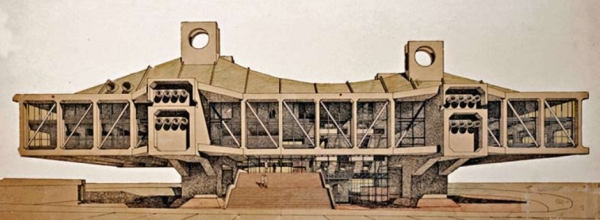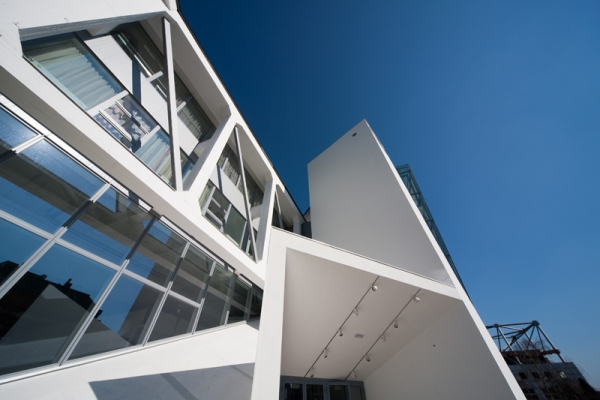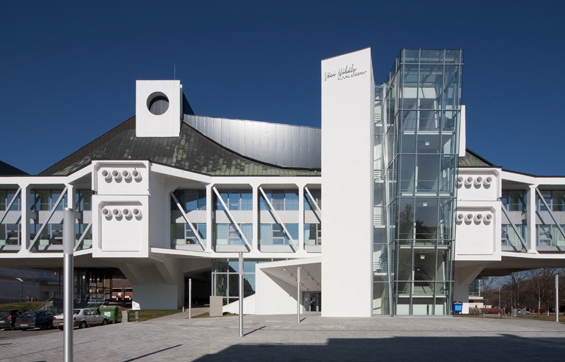A Pathetic Venture
Cultural Centre, Nyíregyháza
Architect: Ferenc Bán
Text: Levente Szabó
Photos: Tamás Bujnovszky


It is quite difficult to place Ferenc Bán’s oeuvre in trends, as it features major and significant buildings as well as several schemes which have remained in blueprint and winning designs submitted for tenders besides experimental concepts. The finished buildings are self-evidently authentic imprints of their own times, as well as reflections of the changing architectural thinking of the architect. In 1969 an invitational tender was published to design this building. The architects’ team invited to it commissioned Ferenc Bán, who was 30 years old then, to work out the project application. The scheme he elaborated broke away from the formulas used for culture centres typical of the period which often integrated prefab panels and resulted in schematic solutions, and he came up with a concept featuring a unique approach and structure. In this project he envisioned a large-scale structure elevated from the ground: beneath the house he planned to have an integral urban plaza, whilst in the large structures he housed flexible cultural functions. This concept, however, also reflects the fact that Bán’s attention was evidently attracted by contemporary Japanese architecture.
The architectural manifests of the wish to break out or differ from others inordinately and deceptively unreal compared to the reality of Hungarian construction, culture and architecture prevailing then in Hungary, to promise a simple process regarding the realization-execution stage. Moreover, the ambition of this young architect actually materialized in a genuinely extreme structure: not only because he planned this large-scale building exclusively from structures consisting of cast on site and less typically, from prefab elements also made on the construction site, but also because these structures in themselves were difficult challenges for the designers owing to their large spans. The idealistic concept of the first version reminds me the most of the concept of Japanese metabolism which is set in the framework of fixed large structures and changeable flexible spaces (in the present case in capsules). According to this, the scheme submitted for the tender is a large-scale monolith made of reinforced concrete set on plinths lifted onto longitudinal lateral grids crossed by struts in a Vierendel-system – which means that there are no diagonal elements to hinder free and flexible usage of space. The drawing showing this expresses most precisely the dual ambition of the building and its desire to get free: the expression of its similarities with current international trends and the need to get rid of and break the restrictions imposed upon it by Hungarian construction industry.
The elevated five-tract level of the entrance houses the foyer, minor rooms and offices, whilst upstairs it would have contained a larger hall and community foyer that could be opened into each other under the same stretched roofing. Whilst the minor rooms and offices of the culture centre would occupy the zones of the in-between floor as a changeable secondary layer, the two larger rooms are housed on the second topmost rooms with a fixed interior. On both sides there are imposing stairs on the facade that lead to the elevated level of the entrance. Communication between the various levels is facilitated by the facade stairs flanking the foyer between the two pylon plinths.
The abstract concept of the urban-scale mega-structure component was replaced in Nyíregyháza with the ambition to express individuality meant to counteract the period of uniformity. In an era when construction industry typically dictated to use prefab construction technology, the integration of monolith concrete surfaces were technologically complex challenges and thus a specialty, although the building was modified several times with significant and disadvantageous effects. Despite the original flexibility of the building which rooted in metabolism, the building underwent basic changes that had proven disadvantageous. Lifted off from the ground, the large structure meant more restrictions rather than it offered freedom. The areas beneath the building could never turn into a genuine live urban plaza and the changes in the neighbourhood of the building as well as the development of other areas of the town also had their counter-effects on other areas of Nyíregyháza. The glazed cube on the ground floor which facilitates transparency beneath the bridge structure was soon developed, the glazing was concealed and the interior circle-shaped piercings of the roofing were eliminated. During a period of more than thirty years the physical condition of the building deteriorated, the mechanical engineering system evidently lost its modernity, and although the quality and aesthetics of the reinforced concrete structures has not changed a bit, the sustainability of the building itself is challenged.

However, we may talk of ageing also in the functional sense, as the original functions of educational, cultural and methodology centre has turned out to be impossible to interpret. What is more, a theatre was built meanwhile in the city which naturally attracted some of the performances from the culture house. Several schemes have been worked out for the remodelling of the culture house in Nyíregyháza. In 2009 an invitational tender was published for which Bán designed the building and a land-art style theatre hall sunk underneath the terrain level to bulge from it. The concept interpreting the environment of the building as an artificial landscape was just adjusted to the artpiece character of the thirty-year-old building. The functional programme essentially preserved the spatial organisation of the former entrance level intact, whilst placed the entrance in the glazed cube. This ground-floor utilization as well as the topographical intervention in the terrain underneath the building, the various degree of infilling the level of the terrain have the potential to use the semi-open plaza as an urban space. However, the concept radically transformed the roof-level as well as the system of communication passages necessary because of this. Designed to be flexible, the roof level has never been built as such. A large hall and a lesser performance space were constructed as fixed and separated units. During the reconstruction stage completed in 2014, these two rooms were demolished and replaced with a multifunctional space suited for performances, which is actually similar to the culture centre completed in 2014 in Nyírbátor. This solution had undoubtedly the advantage that by shifting the lower part of the auditorium the concept of an open space previously included in the scheme could be realized, but also had the disadvantage that the central section of the roof imitating a stretched structure composed onto the two pylons had to be pulled down. The remodelling in 2014 significantly changed both the interior and the exterior of the building. However, it seems that the power radiated by the large structure is still overwhelming.
Client: Nyíregyháza MJV
Original design (tervezés: 1969–74, kivitelezés: 1975–1981): Ferenc Bán
Fellow architects: Zoltán László
Structure: Béla Scholtz – NYÍRTERV
Leading architects (2013-2014): Ferenc Bán, Szabolcs Tenkely – „A” Stúdió’90 Kft.
Fellow architects: Gyöngyi Eichinger, Norbert Kótai, Norbert Nyitrai, Gergely Tomku
Structure: Zsolt Méry – Pro-Stat Kft.
Acoustics: András Kotschy – Kotschy és Társai Kft.)
HVAC: Péterné Görgey, Erzsébet Bihary, János Bukovics – G&B Plan Kft.
Electrical engineering: Ferenc Rajkai – Hungaroproject Mérnökiroda Kft.)
Roads, traffic, public utilities: Miklós Bartha – Bartherv Bt.
Landscape: Péter Márton – Fő-Kert-Ész Bt.
Main contractor: Fatum Property Kft., Bau-Vertikál Kft., Mor-ex Kft.








